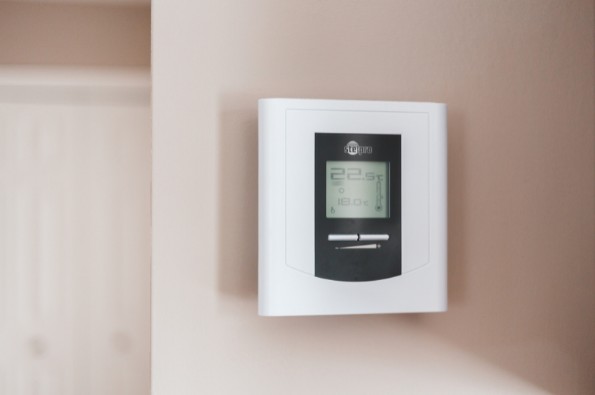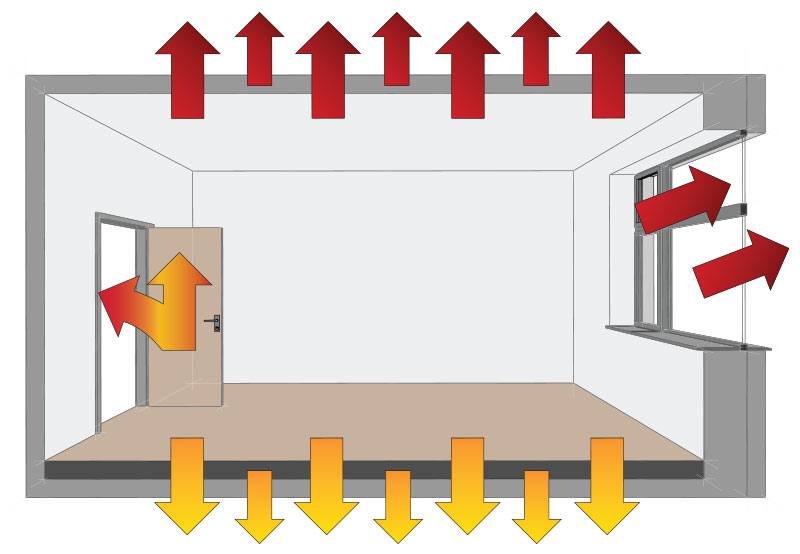
The energy that you use to heat your water and living space typically accounts for about two-thirds of your monthly power bill. During the winter, the power used to heat the average American home causes nearly four tons of greenhouse gases to be emitted into the atmosphere per home each month.
By following the methods below, you can cut back the amount of energy that you use for heating and reduce the price that you—and the environment—pay each month as a result.
Table of Contents
Program Your Thermostat

A programmable thermostat allows you to set a schedule that adjusts the temperature in your home at different points throughout the day. For instance, you can specify what you want the temperature to be from 8 a.m. to 5 p.m. (when you’ll likely be at work), from 5 p.m. to 10 p.m. (when you’ll likely be at home), and from 10 p.m. to 7 a.m. (when you’ll likely be asleep).
A programmable thermostat allows you to use the least amount of energy for heating as possible—you might even be able to get away with using little or no heat while you’re at work or asleep. This type of thermostat costs about $100 and can cut energy costs by 20%.
Which Settings Should You Use?
Experts recommend a setting of 68°F during daylight hours (or whenever you’re home) and 58°F at night (or whenever you’re not at home). Just be sure never to set the minimum temperature below 55°F—this helps prevent the unwelcome consequences of extreme cold, such as frozen pipes.
Once you’ve arrived at settings that feel comfortable, try reducing by 2°F the minimums that you’ve set. This minor adjustment could lower your monthly heating bill by as much as 8%. It’s easy to offset incremental changes by wearing heavier clothing or using thicker blankets at night.
Concentrate Heat in the Areas You’re Using
Just as it makes sense to limit lighting to the spaces that you inhabit, it’s also smart to concentrate your heat in the areas of your home that you’re actually using.
The most effective way to conserve heat is by closing the doors to rooms that you’re using or that you intend to use. Shutting the door will help the room heat up more quickly and prevent the heat from escaping into rooms that you’re not using.
Stop Heat Leaks

Before you pump heat into your living space, make sure that your space is free of leaks. To find and fix leaks:
- Install door sweeps: A door sweep is a long strip of rubber that attaches to the bottom of a door to help seal off the space under the door. If you’d rather not use door sweeps, buy a cheaper fabric version, such as the popular Draft-Dodger®, to do the job.
- Apply caulk and insulation strips: Use caulk and insulation strips (also called weather stripping) to seal the edges of windows and the inside edge of doors (the side with the hinges). Sealing doors and windows can cut your energy bill significantly and conserve as much as 1,100 pounds of annual CO2 emissions per home.
- Modernize windows: Replacing old windows with argon-filled double- or triple-glazed windows will drastically cut down on drafts and heat leaks.
- Insulate walls: Adding insulation to your home’s walls makes a huge difference in heat retention and can reduce monthly heating bills by 15% or more. The type of insulation that you should use varies based on your home’s age and your climate, so it’s best to consult a professional insulation company to help you choose and install new insulation.
- Ventilate with fans: Since hot air rises, most rooms lose lots of heat through the ceiling. You can counteract this easy-to-overlook cause of heat leaks by using a ceiling fan. Though it might seem odd to use a fan in winter, running a fan on a low setting will make your heating system more efficient by keeping warm air closer to the floor—it won’t create a chilly breeze.
- Draw drapes at night: Drawing drapes and closing blinds adds an extra level of insulation to windows to stop drafts and heat leaks. You can even buy specially made insulation-lined drapes for this purpose.
- Locate persistent leaks: Even after you’ve implemented some or all of these suggestions, it’s still a good idea to track down the remaining leaks in each room of your home. To do so, light a candle on a windy day, close the windows and doors in the room that you’re inspecting, and then walk the perimeter of the room. Watch the candle carefully and stop in your tracks when you see the flame start to move unexpectedly. Follow the “trail” of the leak to identify its source. Once you find the source, use caulking or insulation strips—or whatever method is most appropriate—to seal it off.
Reduce Hot Water Use and Expense
The average home spends 13% of its energy bill on heating water. There are a number of ways you can cut down on these costs.
- Use less hot water: Short of taking cold showers and washing dishes with cold water, one of the most effective ways to reduce the amount of hot water you use is to install a low-flow aerator on all of your faucets and shower heads. These specially designed aerators can reduce your water usage (and water heating–related expenses) by 50%. Faucet models cost roughly $5–10; shower models, $25–50.
- Lower your water heater’s thermostat: Water heater thermostats are usually set to 130–140°F. Try lowering yours to 110–120°F instead. Every 10°F reduction saves 600 pounds of CO2 per year for electric heaters and 440 pounds of CO2 for gas heaters.
- Upgrade your water heater: If your water heater is more than 10 years old, replace it. Consider installing a tankless water heater, which is typically much more energy efficient than a standard tank-based model.
- Insulate your water heater: If you have a water heater with a tank, surrounding it with an insulation blanket (also called an insulation jacket) can save 5–10% on heating costs annually. Insulation blankets cost $15–30 and can be found at hardware stores and home centers.

